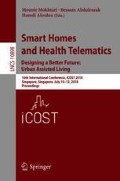Abstract
In this article, the analysis of pure movements of the lower limb of the human being applied to the design of exoskeletons is explained, in order to be able to obtain bases for the selection of which meet the appropriate torque requirements that can move the robot and help perform continuous trajectories. These values are based on the trajectories that are obtained by measuring the orientation of the lower limb while the patient performs pure rehabilitation movements.
Having these movements fully developed, a communication can be applied by Bluetooth protocol, in such a way that signals are sent between the two parts of the exoskeleton of the lower limb to generate a successive walk clearly necessary in the rehabilitation.
Access this chapter
Tax calculation will be finalised at checkout
Purchases are for personal use only
References
Albán, O.A.V.: Aplicaciones de la Robótica al Campo de la Medicina. Universidad del Cauca (2007)
Galeano, D.: Robótica Médica. Universidad Católica Nuestra Señora de la Asunción (2016)
Mera, I.L.L., Daza, M.M.: Exoesqueleto para Reeducación en Pacientes con IMOC Tipo Diplejía Espástica Moderada. Universidad del Cauca (2010)
Sierra, H.A.: Control de un Exoesqueleto para Asistir en la Bipedestación y la Marcha de una Persona. Centro de Investigación y de Estudios Avanzados del Instituto Politécnico Nacional, David Martínez Alberto., “Análisis Cinemático y Dinámico del Robot Pasibot”., Universidad Carlos III de Madrid (2008)
Giraldo, A.F.M.: Caracterización Mecánica y Dinámica del Robot SCARA UV-CERMA (2014)
Instituto de Biomecánica de Valencia. GAIT Ortesis Inteligente para Rodilla y Tobillo (2006)
Burgos, P.S.J.: Desarrollo de un interfaz de usuario para guante de datos 5DT Data Glove. Universidad de Valladolid (2017)
Lajeunesse, V., Vincent, C., Routhier, F., Careau, E., Michaud, F.: Exoskeletons’ design and usefulness evidence according to a systematic review of lower limb exoskeletons used for functional mobility by people with spinal cord injury. J. Disabil. Rehabil. Assist. Technol. 11(7), 535–547 (2016)
Huo, W., et al.: Lower limb wearable robots for assistance and rehabilitation: a state of the art. IEEE Syst. J. 10(3), 1068–1081 (2014)
Baluch., T.H., et al.: Kinematic and dynamic analysis of a lower limb exoskeleton. International Science Index (2012)
Chen, B., et al.: Recent developments and challenges of lower extremity exoskeletons. J. Orthop. Transl. 5, 26–37 (2016)
Kwak, N.S., Müller, K.R., Lee, S.W.: A lower limb exoskeleton control system based on steady state visual evoked potentia. J. Neural Eng. 12, 056009 (2015)
Author information
Authors and Affiliations
Corresponding author
Editor information
Editors and Affiliations
Rights and permissions
Copyright information
© 2018 Springer International Publishing AG, part of Springer Nature
About this paper
Cite this paper
Herrera, M.C.S., Parra, O.J.S., Medina, J. (2018). Generation of Pure Trajectories for Continuous Movements in the Rehabilitation of Lower Member Using Exoskeletons. In: Mokhtari, M., Abdulrazak, B., Aloulou, H. (eds) Smart Homes and Health Telematics, Designing a Better Future: Urban Assisted Living. ICOST 2018. Lecture Notes in Computer Science(), vol 10898. Springer, Cham. https://doi.org/10.1007/978-3-319-94523-1_24
Download citation
DOI: https://doi.org/10.1007/978-3-319-94523-1_24
Published:
Publisher Name: Springer, Cham
Print ISBN: 978-3-319-94522-4
Online ISBN: 978-3-319-94523-1
eBook Packages: Computer ScienceComputer Science (R0)

